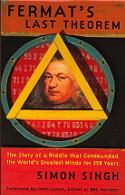Pierre de Fermat
The Anecdote About Fermat's Last Theorem
In the margin of his copy of a book by Diophantus, Pierre de Fermat wrote that it is possible to have a square be the sum of two squares, but that a cube can not be the sum of two cubes, nor a fourth power be a sum of two fourth powers, and so on. Further, he wrote that he had found a truly marvelous proof which the margin was too small to contain.
That is to say, there are no integers x, y, z such that x^3 + y^3 = z^3, or integers x, y, z such that x^7 + y^7 = z^7. Although this is easily stated, it has proved to be one of the most difficult problems in the whole history of mathematics. Long after all the other statements made by Fermat had been either proved or disproved, this remained; hence it is called Fermat's Last Theorem.
This was worked on by many famous mathematicians. Fermat himself proved this theorem for n = 4, and Leonhard Euler did n = 3. New theories were developed to attack the problem, but all attempts at a general proof failed. They failed, that is, until this decade, when, building on work of many famous mathematicians, Professor Andrew Wiles of Princeton University finally proved it. Fermat's "truly marvelous proof" is now believed to have been faulty.
The actual proof is very indirect, and involves two branches of mathematics which at face value appear to have nothing to do either with each other or with Fermat's theorem. The two subjects are elliptic curves and modular forms and involve work done previously by Taniyama and Shimura. The Dr. Math Archives offer a brief description of what these are and how they relate to Fermat's Last Theorem. The greatest difficulty was in proving that the Taniyama-Shimura conjecture was true. This is the contribution made by Andrew Wiles, and the final stage in establishing Fermat's Last theorem.
That is to say, there are no integers x, y, z such that x^3 + y^3 = z^3, or integers x, y, z such that x^7 + y^7 = z^7. Although this is easily stated, it has proved to be one of the most difficult problems in the whole history of mathematics. Long after all the other statements made by Fermat had been either proved or disproved, this remained; hence it is called Fermat's Last Theorem.
This was worked on by many famous mathematicians. Fermat himself proved this theorem for n = 4, and Leonhard Euler did n = 3. New theories were developed to attack the problem, but all attempts at a general proof failed. They failed, that is, until this decade, when, building on work of many famous mathematicians, Professor Andrew Wiles of Princeton University finally proved it. Fermat's "truly marvelous proof" is now believed to have been faulty.
The actual proof is very indirect, and involves two branches of mathematics which at face value appear to have nothing to do either with each other or with Fermat's theorem. The two subjects are elliptic curves and modular forms and involve work done previously by Taniyama and Shimura. The Dr. Math Archives offer a brief description of what these are and how they relate to Fermat's Last Theorem. The greatest difficulty was in proving that the Taniyama-Shimura conjecture was true. This is the contribution made by Andrew Wiles, and the final stage in establishing Fermat's Last theorem.

